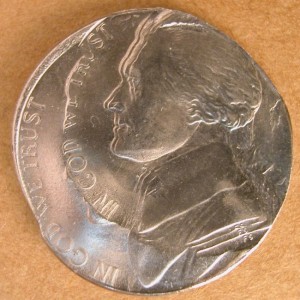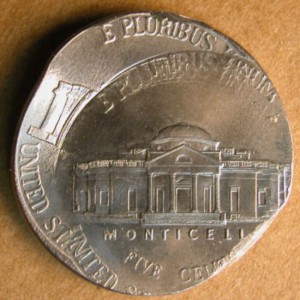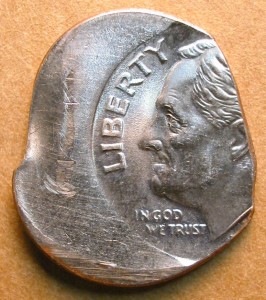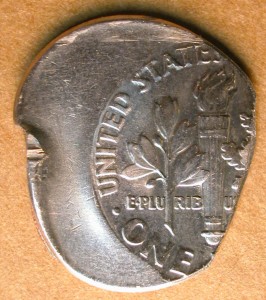VI. Striking Errors:
Intra-Strike Damage
Definition: Damage to a coin or planchet that occurs during the strike but outside the boundaries of the striking chamber. The damage is not caused directly or indirectly by the dies, collar, or other coins or planchets that occupy the striking chamber at the same time. The damage is instead caused by a feeder, ejector, some other machine part, or an unknown obstruction.
Intra-strike damage occurs in two ways:
- The unstruck portion of an off-center planchet collides with an obstruction as it is pushed sideways by the expansion of the struck tongue of metal. This produces a contact facet at the pole opposite the internal margin of the die-struck area. The contact facet is typically flat and devoid of any texture. The planchet may buckle from being trapped between the dies at one pole and forced against the obstruction at the opposite pole. Intra-strike damage of this sort is most commonly found in nickels and the flat facet is invariably located opposite the base of Jefferson’s bust at a consistent distance. This kind of intra-strike damage is much less frequently found among Lincoln cents. It has not been identified in any other denomination.
- The unstruck portion of an off-center coin or planchet is pushed into a feeder/ejection finger by the expansion of the struck portion of the coin and the struck portion of the opposing feeder/ejection finger. This sort of damage typically takes the form of a dent in the edge of that portion of a planchet or multi-struck coin that protrudes outside the striking chamber. The dent is sometimes deep and may cause the adjacent coin metal to buckle. These dents are always associated with coins struck by inverted dies installed in the high-speed Schuler press. The vast majority of these coins are multi-struck. The opposite pole almost always shows a foreign object chain strike (from the other feeder/ejection finger). Together, the dent and the foreign object chain strike comprise a pattern of bilateral machine part impingement.
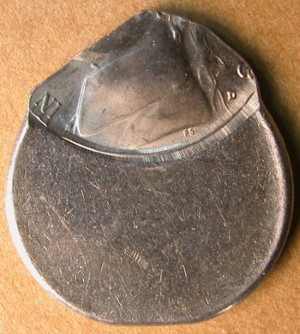
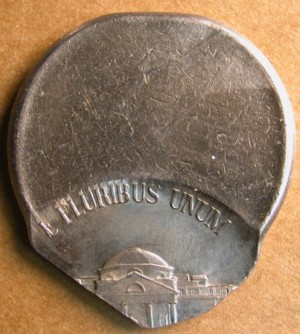
In this off-center nickel, the pole opposite the off-center strike was flattened by contact with an immovable object. As the coin metal expanded beneath the dies, the unstruck part of the planchet was pushed laterally into the obstruction. It’s not clear whether the object was a feeder/ejector, but that’s one possible candidate. The flat contact facet characteristically lies opposite the base of Jefferson’s bust. These errors should not be confused with sideneck strikes. These leave a concave contact facet that results from a collision with the side of the hammer die that belongs to the adjacent die pair in a dual or quad press.
This off-center strike also features a chain strike, but this has no relationship to the formation of the flat contact facet.
This nickel received a normal first strike and then three closely-spaced off-center strikes. It was struck with inverted dies (reverse die as hammer die) and was almost certainly struck in a Schuler press.
A dent can be seen on the left side of the coin’s edge next to the W of WE. This area of intra-strike damage was produced when the portion of the coin lying outside the striking chamber was pushed laterally into a feeder/ejection finger. The expansion of that portion of the coin and the adjacent feeder/ejection finger that lay inside the striking chamber provided the necessary lateral force. At the pole opposite the intra-strike damage we see a foreign object chain strike, produced when the edge of the nickel and the internal edge of the feeder/ejector finger flowed together.
This off-center dime displays a case of bilateral machine part impingement. On the left side, we see a dent from the left-side feeder/ejection finger. The impact on the edge was so forceful that the unstruck portion of the dime buckled. This area of intra-strike damage lies directly across from a foreign object chain strike produced by edge-to-edge contact with the right-side feeder/ejection finger.
